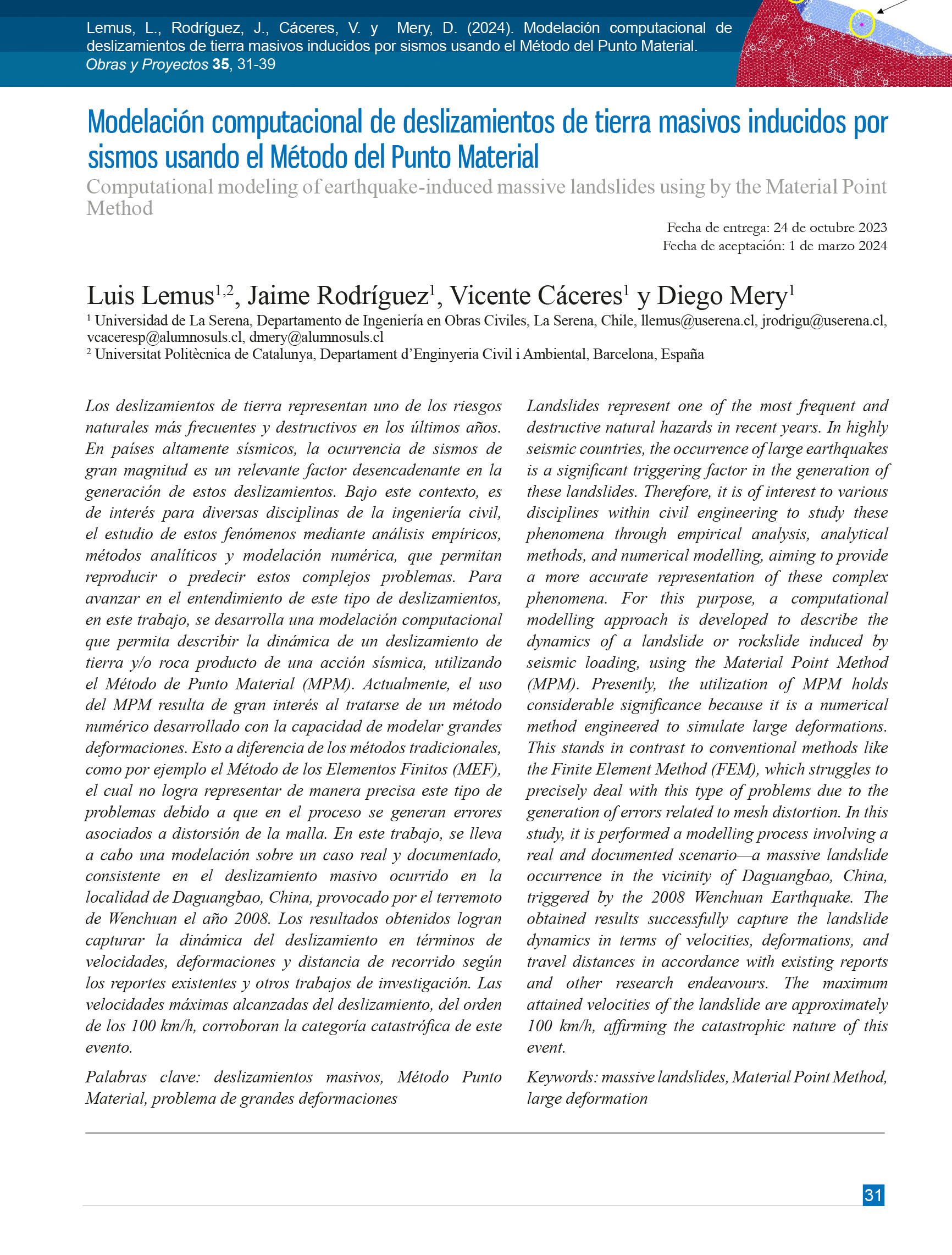Modelación computacional de deslizamientos de tierra masivos inducidos por sismos usando el Método del Punto Material
DOI:
https://doi.org/10.21703/0718-2813.2024.35.2797Palabras clave:
Deslizamientos masivos, Método Punto Material, Problema de grandes deformacionesResumen
Los deslizamientos de tierra representan uno de los riesgos naturales más frecuentes y destructivos en los últimos años. En países altamente sísmicos, la ocurrencia de sismos de gran magnitud es un relevante factor desencadenante en la generación de estos deslizamientos. Bajo este contexto, es de interés para diversas disciplinas de la ingeniería civil, el estudio de estos fenómenos mediante análisis empíricos, métodos analíticos y modelación numérica, que permitan reproducir o predecir estos complejos problemas. Para avanzar en el entendimiento de este tipo de deslizamientos, en este trabajo, se desarrolla una modelación computacional que permita describir la dinámica de un deslizamiento de tierra y/o roca producto de una acción sísmica, utilizando el Método de Punto Material (MPM). Actualmente, el uso del MPM resulta de gran interés al tratarse de un método numérico desarrollado con la capacidad de modelar grandes deformaciones. Esto a diferencia de los métodos tradicionales, como por ejemplo el Método de los Elementos Finitos (MEF), el cual no logra representar de manera precisa este tipo de problemas debido a que en el proceso se generan errores asociados a distorsión de la malla. En este trabajo, se lleva a cabo una modelación sobre un caso real y documentado, consistente en el deslizamiento masivo ocurrido en la localidad de Daguangbao, China, provocado por el terremoto de Wenchuan el año 2008. Los resultados obtenidos logran capturar la dinámica del deslizamiento en términos de velocidades, deformaciones y distancia de recorrido según los reportes existentes y otros trabajos de investigación. Las velocidades máximas alcanzadas del deslizamiento, del orden de los 100 km/h, corroboran la categoría catastrófica de este evento.
Referencias
Al-Kafaji, I.K.J. (2013). Formulation of a Dynamic Material Point Method (MPM) for Geomechanical problems. PhD thesis, Stuttgart University, Germany.
Alonso, E.E. (2021). Triggering and motion of landslides. Géotechnique 71(1), 3-59.
Alsardi, A. and Yerro, A. (2023). Coseismic site response and slope instability using periodic boundary conditions in the material point method. Journal of Rock Mechanics and Geotechnical Engineering 15(3), 641-658.
Andersen, S. and Andersen, L. (2010). Modelling of landslides with the material-point method. Computational Geosciences 14(1):137–147.
Angeli, M.G., Gasparetto, P., Menotti, R.M., Pasuto, A. and Silvano, S. (1996). A visco-plastic model for slope analysis applied to a mudslide in Cortina d’Ampezzo, Italy. Quarterly Journal of Engineering Geology and Hydrogeology 29(3), 233-240.
Beuth, L. (2012). Formulation and application of a quasistatic material point method. PhD thesis, Stuttgart University, Germany.
Jassim, I., Stolle, D. and Vermeer, P. (2013). Two-phase dynamic analysis by material point method. International Journal for Numerical and Analytical Methods in Geomechanics 37(15), 2502–2522.
Kohler, M., Stoecklin, A. and Puzrin, A.M. (2022). A MPM framework for large-deformation seismic response analysis. Canadian Geotechnical Journal 59(6), 1046-1060.
Pinyol, N.M., Alvarado, M., Alonso, E.E. and Zabala, F. (2018). Thermal effects in landslide mobility. Géotechnique 68(6), 528-545.
Prieto, A.F., Cantor, L.C. and Rodríguez, C.E. (2020). Modelo de bloque deslizante para analizar el comportamiento cinemático de deslizamientos en suelos a partir de las fuerzas resultantes de un modelo de equilibrio límite. Obras y Proyectos 27, 64-77.
Song, Y., Huang, D. and Cen, D. (2016). Numerical modelling of the 2008 Wenchuan earthquake triggered Daguangbao landslide using a velocity and displacement dependent friction law. Engineering Geology 215, 50-68.
Sulsky, D., Chen, Z. and Schreyer, H.L. (1994). A particle method for history-dependent materials. Computer Methods in Applied Mechanics and Engineering 118(1-2), 179-196.
Sulsky, D. and Schreyer, H.L. (1996). Axisymmetric form of the material point method with applications to upsetting and Taylor impact problems. Computer Methods in Applied Mechanics and Engineering 139(1-4), 409-429.
Wieckowski, Z. (2004). The material point method in large strain engineering problems. Computer Methods in Applied Mechanics and Engineering 193(39-41), 4417–4438.
Yerro, A., Alonso, E. and Pinyol, N. (2013). The Material Point Method: A promising computational tool in Geotechnics. 18th International Conference on Soil Mechanics and Geotechnical Engineering, Paris, France, 853–856.
Zabala, F. and Alonso, E.E. (2011). Progressive failure of Aznalcóllar dam using the material point method. Géotechnique 61(9), 795–808.
Zhang, Y., Zhang, J., Chen, G., Zheng, L. and Li, Y. (2015). Effects of vertical seismic force on initiation of the Daguangbao landslide induced by the 2008 Wenchuan earthquake. Soil Dynamics and Earthquake Engineering 73, 91-102.

Descargas
Publicado
Número
Sección
Licencia

Esta obra está bajo una licencia internacional Creative Commons Atribución-NoComercial 4.0.







